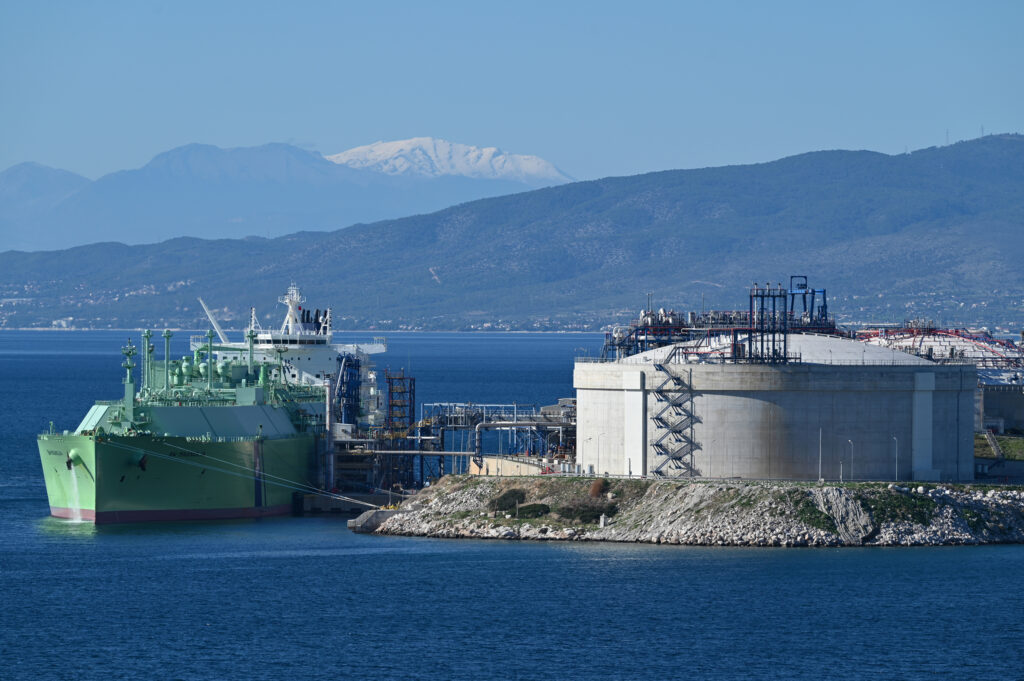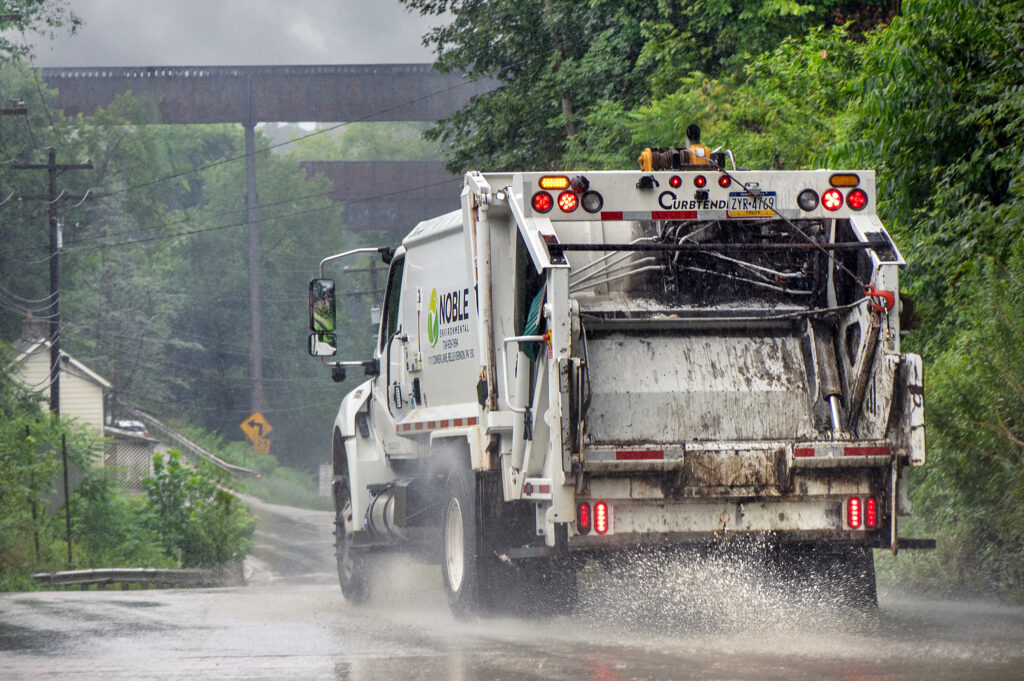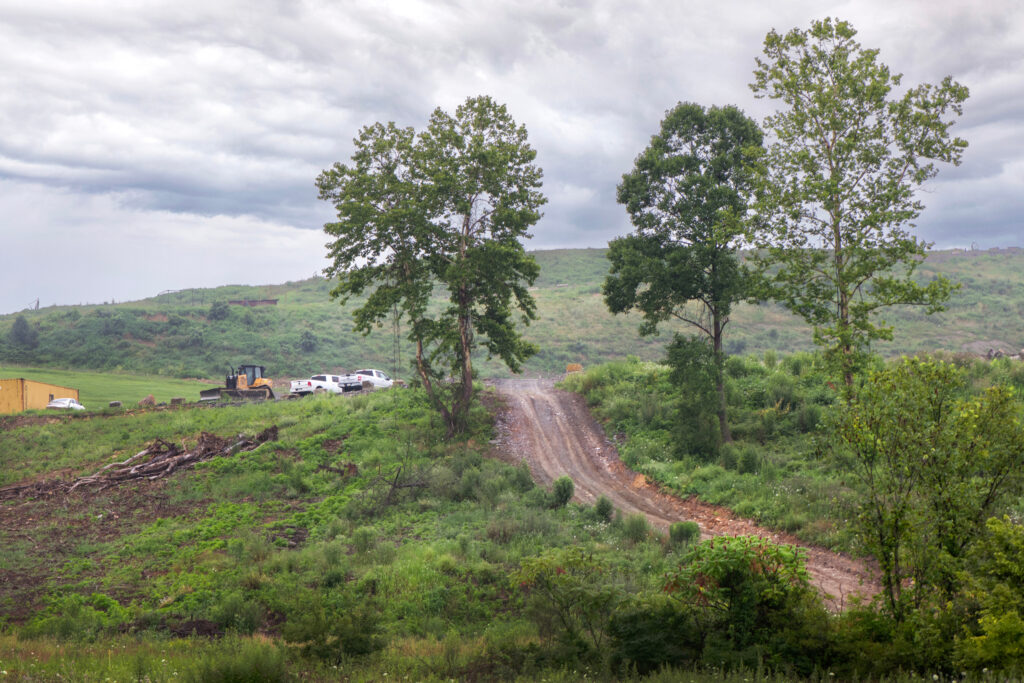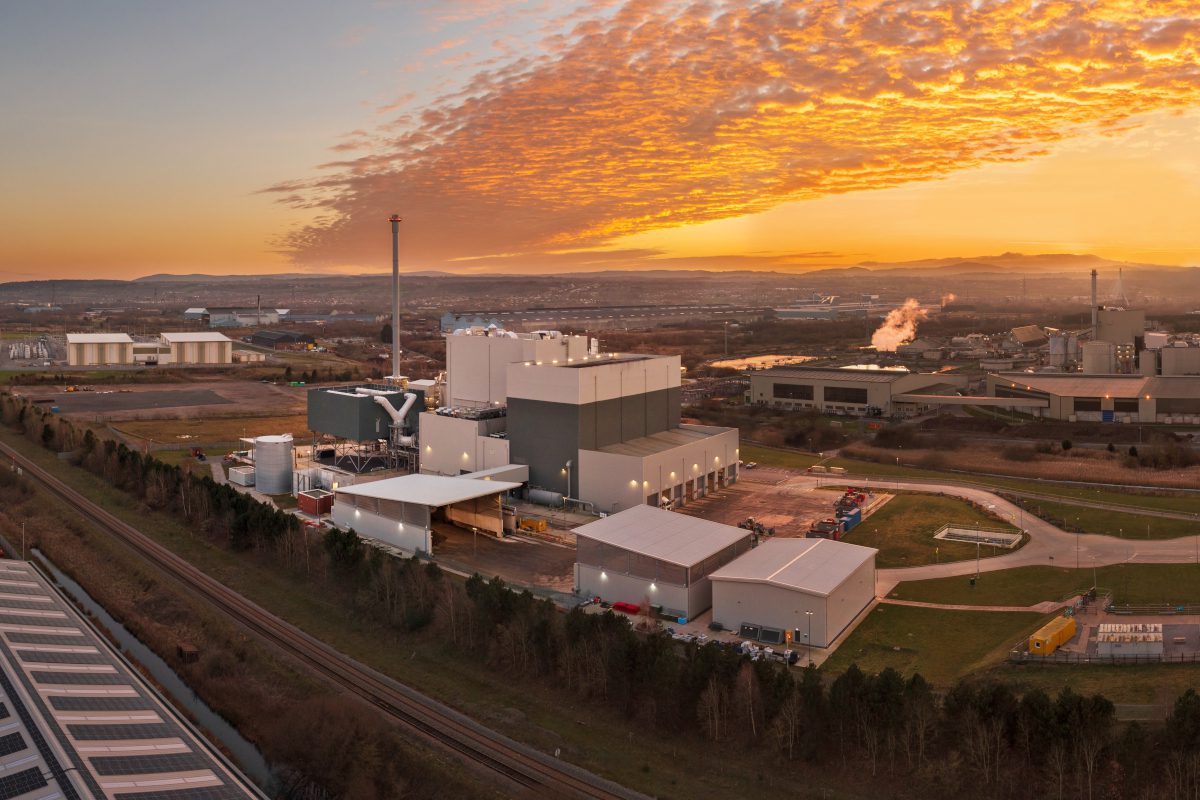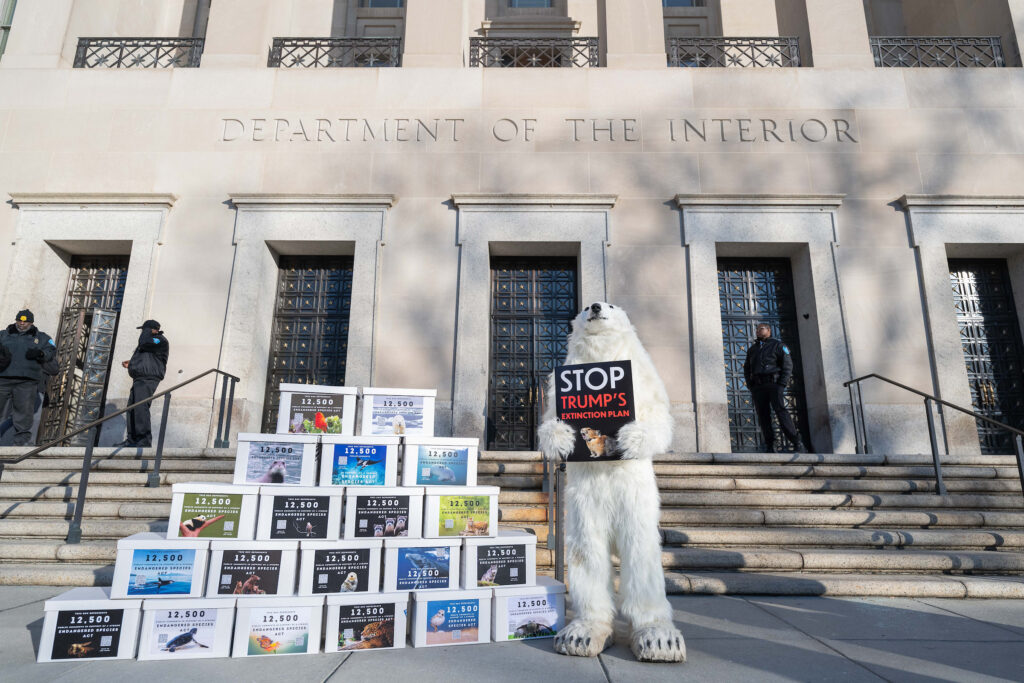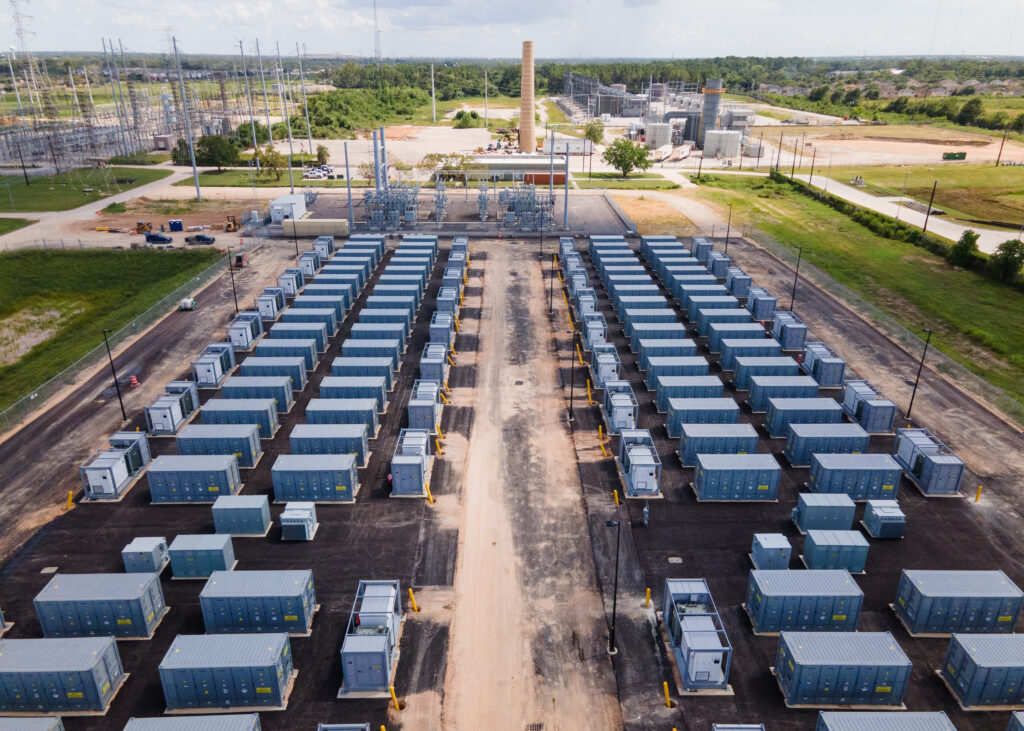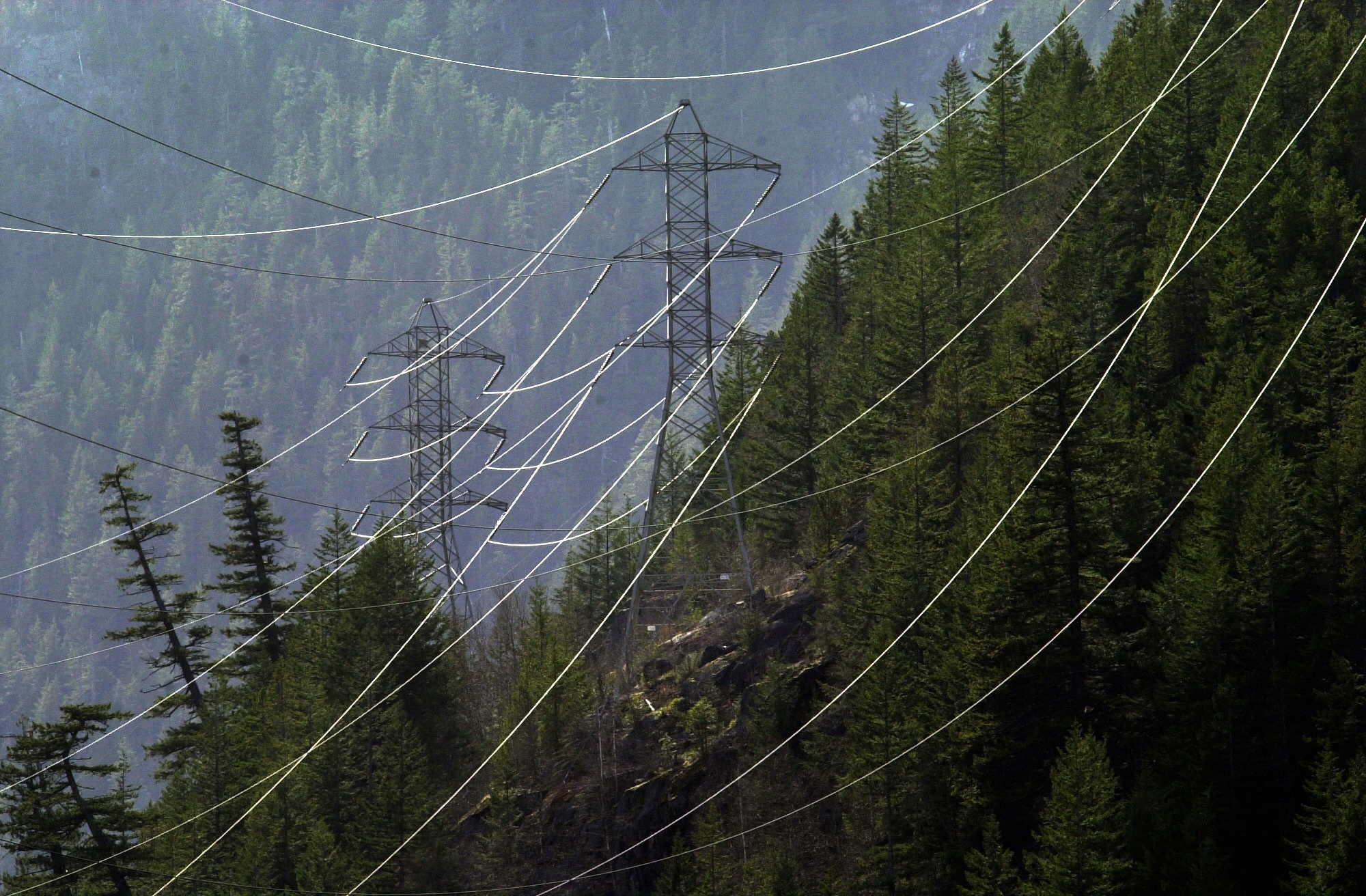CAMERON, La.—For a ship the length of nearly three football fields, Energy Intelligence seemed to turn on a dime. With tugboats pushing and pulling at its bow and stern, the 295-meter liquefied natural gas tanker pivoted 180 degrees in the brackish waters of the Calcasieu Ship Channel in late February, preparing to refuel for a trip to the Netherlands.
Its journey is part of a seismic shift that in the past decade has seen the U.S. go from an LNG importer to the world’s largest exporter, fueled by an ongoing boom in hydraulically fractured natural gas. New U.S. export terminals and expansions currently under construction will nearly double existing export capacity in the coming years, while even more projects have been approved.
Scientists have warned that LNG production involves significant greenhouse gas emissions at every step in the process, from methane leaks at wells to the burning of the gas by end users. But there’s been little attention to the impact of emissions from the tankers that ship LNG from the U.S. to other countries.
That too is substantial, an Inside Climate News analysis found. A single year of greenhouse gas emissions from tankers carrying LNG from the United States more than cancels out the annual emissions reductions achieved through all the electric vehicles currently on U.S. roads.
We’re hiring!
Please take a look at the new openings in our newsroom.
See jobs
To estimate the climate pollution from vessels exporting U.S. LNG, Inside Climate News analyzed federal export data, information from the International Gas Union on the ships’ capacities and propulsion systems and ship tracking data supplied by the maritime analytics provider MarineTraffic.
The first-of-its-kind analysis totaled emissions for two one-year periods: between April 1, 2017 and March 31, 2018, shortly after large-scale exports from the U.S. began with the opening of the Sabine Pass export facility in Louisiana, and again between April 1, 2023 and March 31, 2024.
Inside Climate News found that total greenhouse gas emissions more than quadrupled from about 4.1 million metric tons of CO2 equivalent for 224 return journeys in 2017-2018 to around 18.4 million tons for 1,265 journeys in 2023-2024. To put the latter figure in perspective: It equals the annual greenhouse gas reductions from swapping 5.8 million gasoline-powered vehicles with an equal number of electric vehicles.
That’s around 50 percent more than all the light-duty EVs currently registered in the United States.
It’s “a big deal,” said Mark Brownstein, the Environmental Defense Fund’s energy transition senior vice president.
“Methane from human activities drives nearly a third of the warming that the planet is experiencing right now,” he said. “Every molecule of methane, whether lost at the well site, the pipeline, the ship or the power plant is working to accelerate warming at a time when the climate crisis is bearing down on countries around the world.”
The Inside Climate News analysis drew on methods described in a scientific study published in 2023, which accounted for the age of each ship, its specific propulsion system, the distance the tanker traveled, the capacity of its LNG tanks and the time each ship spent maneuvering and docked.
Importantly, these calculations accounted for both the release of CO2 from vessels’ engines and emissions of unburned methane that passes through the engines of tankers that are fueled by gas boiling off from their cargo tanks. Across the entire fleet involved in U.S. exports of LNG, this “methane slip” accounted for more than half of all CO2-equivalent emissions.
Methane, the primary component of LNG, is the second leading driver of climate change after carbon dioxide. On a pound for pound basis, it’s far more effective than CO2 at warming the planet in the 20 years after it’s released. And because methane remains in the atmosphere for a relatively short amount of time compared to carbon dioxide, reducing methane emissions is widely viewed as the fastest way to combat climate change.
The portion of emissions from shipping is modest relative to the total climate pollution associated with LNG. A recent peer-reviewed study suggests that shipping accounts for 6 percent of LNG-associated greenhouse gas emissions, with the vast majority coming from production wells and end use, when gas is burned for heating or to produce electricity.
The study concluded that the total climate pollution associated with exported U.S. LNG is higher than that of coal produced in the importing countries. Natural Allies for a Clean Energy Future, a group that supports the natural gas industry, funded a July 2024 report that did not go through academic peer review and came to the opposite conclusion.
Putting the ICN finding in the context of vehicle use makes it all the more striking, said Ade Samuel, an energy analyst at the Natural Resources Defense Council.
“When you compare it to these numbers of the emissions released from gasoline-powered vehicles, I think it really gives you a sense for how significant the emissions of LNG on the full lifecycle basis are,” Samuel said.
The American Petroleum Institute, which represents the U.S. oil and gas industry, and Natural Allies for a Clean Energy Future both declined to comment on the ICN analysis.
Out of Sight, Out of Mind
While much has been made of methane releases at wells, pipelines and compressor stations in recent years, emissions of methane and CO2 from ships transporting LNG have gone largely unnoticed. Part of the reason is the physical distance of tankers at sea from human observers.
A gap in satellite capabilities is also partly to blame. Satellites can easily detect plumes of methane from oil and gas facilities on land, but the technique, which relies on bouncing light off the ground, has proved more challenging over water.

In addition, tankers passing through international waters occupy an accountability “no man’s land” when it comes to quantifying both the release of methane and CO2 from ships, said Alison Kirsch, a senior energy analyst for the Sierra Club.
“Shipping emissions are not really taken into account by either the exporting country or the importing country,” Kirsch said. “The shipping phase of emissions sort of falls to the wayside.”
The Inside Climate News analysis also revealed a secondary reason for the increased emissions in 2023-2024, beyond the rapid ramp-up in exports: Tankers are making longer journeys to countries in Asia and the west coast of South America, due to companies increasingly routing LNG vessels around the southern tip of South America or South Africa rather than passing through the Panama Canal. Drought–induced low water levels in the canal limited ship traffic through the waterway starting in early 2023.
One vessel bound for Singapore, meanwhile, turned around in the Mediterranean and headed around the tip of South Africa rather than passing through the Suez Canal in November 2023, shortly after Houthi rebels in Yemen began to attack international shipping in the Red Sea. GasLog Partners, the owner of the vessel, did not respond to requests for comment.
Journeys to Taiwan, China and Japan were 13 to 16 percent longer in 2023-2024 than in 2017-2018, while trips to Chile were 31 percent longer. Still, these disruptions to shipping added roughly half a million metric tons to estimated emissions, dwarfed by the vast growth in climate pollution caused by the five-fold explosion in the number of export journeys.
While already poised to continue growing, U.S. LNG exports and their associated emissions may soon expand even further. President Donald Trump pledged to fast-track the approval of additional LNG export capacity and is already making good on his word.
Since he took office, his administration has announced approvals for four large LNG projects, including Calcasieu Pass 2 and Commonwealth LNG, both adjacent to the existing terminal on the Calcasieu Ship Channel, just inland from the Gulf of Mexico.
It’s not clear whether there’s enough demand for the additional LNG export capacity. Tariffs levied by the Trump administration have already resulted in a pause on U.S. LNG imports by China, the world’s largest buyer of the fuel. However, other countries, including Japan, India, Taiwan and Ukraine have pledged to increase imports of U.S. LNG.
Whatever happens, “we need to take a look at this from the point of view of reducing methane emissions and doing whatever we can to make that happen,” said Kirsten Sinclair Rosselot, a chemical engineer and environmental performance analyst who runs the consultancy Process Profiles and was the lead author of the 2023 study that assessed greenhouse gas emissions from individual LNG tankers. “But the end goal is to transition off of fossil fuels, which would eliminate the need for shipping LNG in the first place.”
How Methane Escapes When LNG Is Shipped
LNG is natural gas that has been super-cooled to minus-260 degrees Fahrenheit, a temperature so cold the fuel changes from a gas to a liquid. Liquifying the gas shrinks its volume, allowing LNG tankers to carry approximately 600 times more fuel within their holds than if the fuel remained a gas.
Ships like the Energy Intelligence have thick insulating walls to help keep the LNG cool. However, even with insulation, a portion of the fuel boils off, turning back into a gas. While some boil-off gas may escape the ship as “fugitive emissions” released into the atmosphere, most of the gas is captured and routed to the ship’s engines to power the vessel.
This story is funded by readers like you.
Our nonprofit newsroom provides award-winning climate coverage free of charge and advertising. We rely on donations from readers like you to keep going. Please donate now to support our work.
Donate Now
For a ship’s primary engines, which propel it forward, the amount of unburned methane is low, approximately 2 percent of the total gas that passes through the engine. However, for the auxiliary engines that generate electricity for lighting and other electrical needs on the ship, methane slip can be much higher. This is because auxiliary engines are typically run at low capacity, or “load,” a state at which they do not operate efficiently.
“Where you really see the slip onboard is in the generators,” Rosselot said. “They run the generators at low load, and methane slip is horrific at low load.”
More than 15 percent of the gas that enters an auxiliary engine can pass through the generator unburned when the engines are run at low loads, according to a study published in 2022. The finding was recently confirmed by the Methane Abatement in Maritime Innovation Initiative (MAMII), an industry group whose members include oil giants Chevron, Shell and TotalEnergies, plus several of the largest LNG shipping companies, including MOL, Maran Gas, Seapeak and Knutsen OAS.
“Despite recent progress, methane slip is the key component of onboard emissions,” MAMII stated in a report published in July. The report noted that methane releases “constitute a major risk” for the industry but added that existing technology “can reduce methane slip to a negligible, if not zero, amount.”
“This is solvable,” said Panos Mitrou, MAMII chairman and global gas segment director for Lloyd’s Register, which provides technical advice for the shipping industry. “I think it’s possible to come to a stage where LNG fuel ships, or energy carrying ships, will be what we call ‘methane proof.’ They will have minimal, negligible methane emissions.”


One method to reduce the rate of methane slip suggested in the report is to simply run fewer generators at higher loads. Ship operators typically run multiple generators as a built-in backup to ensure a steady power supply in case one of the generators fails.
The industry report suggested batteries could replace redundant generators as a backup source of power. Another suggested solution was “shaft generators,” devices that harness the rotational motion of the main engine to generate electricity.
To hasten emissions reductions, MAMII went a step further, calling for industry-wide regulations. “It is vital that regulators implement a clear, robust, and focused regulatory framework as soon as possible to incentivise technology development and uptake,” the report stated.
Since January 2024, the European Union has required LNG vessels and other large ships entering EU ports to monitor and report their climate pollution, including methane. Shipping companies will have to pay for excessive methane emissions starting in 2026.
More efforts to reduce that pollution are underway. The United Nations’ International Maritime Organization approved draft regulations April 11 that would put a price on greenhouse gas emissions for the global shipping industry.
However, the global framework is less stringent than the European rules and will not meet the UN agency’s target of reducing greenhouse gas emissions from shipping 30 percent by 2030, said Bryan Comer, the marine program director for the International Council on Clean Transportation.
“We made some progress on decarbonizing maritime shipping, but ultimately, what was agreed this week falls short of IMO’s own goal,” Comer said.
The LNG industry is going to have to rein in methane and carbon pollution, not just on the high seas but from extraction to use, if its exports will “play any kind of constructive role in meeting global energy demands,” said Brownstein, with the Environmental Defense Fund.
Those exports don’t show any sign of slowing down. After unloading its fuel in the Netherlands, Energy Intelligence returned to Calcasieu Pass, ready to ferry its next load of fuel across the Atlantic.
Hannah Marszalek contributed to this story.
About This Story
Perhaps you noticed: This story, like all the news we publish, is free to read. That’s because Inside Climate News is a 501c3 nonprofit organization. We do not charge a subscription fee, lock our news behind a paywall, or clutter our website with ads. We make our news on climate and the environment freely available to you and anyone who wants it.
That’s not all. We also share our news for free with scores of other media organizations around the country. Many of them can’t afford to do environmental journalism of their own. We’ve built bureaus from coast to coast to report local stories, collaborate with local newsrooms and co-publish articles so that this vital work is shared as widely as possible.
Two of us launched ICN in 2007. Six years later we earned a Pulitzer Prize for National Reporting, and now we run the oldest and largest dedicated climate newsroom in the nation. We tell the story in all its complexity. We hold polluters accountable. We expose environmental injustice. We debunk misinformation. We scrutinize solutions and inspire action.
Donations from readers like you fund every aspect of what we do. If you don’t already, will you support our ongoing work, our reporting on the biggest crisis facing our planet, and help us reach even more readers in more places?
Please take a moment to make a tax-deductible donation. Every one of them makes a difference.
Thank you,





